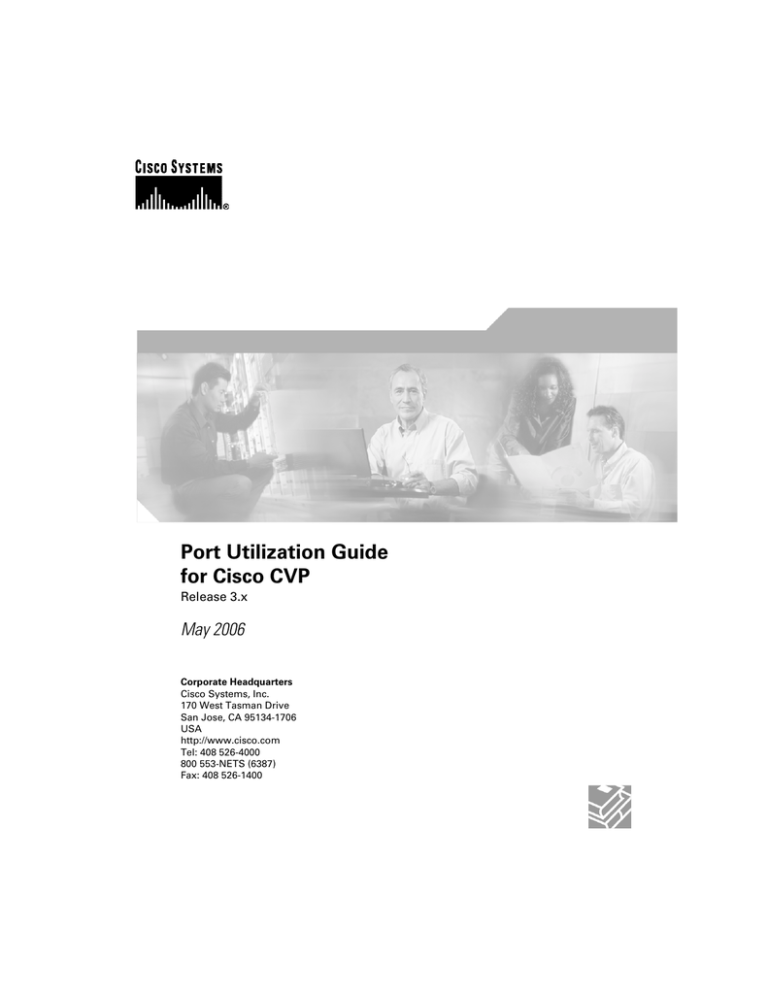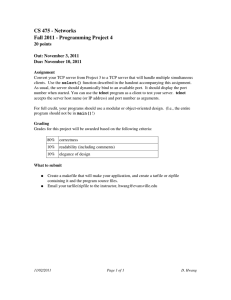
Port Utilization Guide
for Cisco CVP
Release 3.x
May 2006
Corporate Headquarters
Cisco Systems, Inc.
170 West Tasman Drive
San Jose, CA 95134-1706
USA
http://www.cisco.com
Tel: 408 526-4000
800 553-NETS (6387)
Fax: 408 526-1400
THE SPECIFICATIONS AND INFORMATION REGARDING THE PRODUCTS IN THIS MANUAL ARE SUBJECT TO CHANGE WITHOUT NOTICE.
ALL STATEMENTS, INFORMATION, AND RECOMMENDATIONS IN THIS MANUAL ARE BELIEVED TO BE ACCURATE BUT ARE PRESENTED
WITHOUT WARRANTY OF ANY KIND, EXPRESS OR IMPLIED. USERS MUST TAKE FULL RESPONSIBILITY FOR THEIR APPLICATION OF
ANY PRODUCTS.
THE SOFTWARE LICENSE AND LIMITED WARRANTY FOR THE ACCOMPANYING PRODUCT ARE SET FORTH IN THE INFORMATION PACKET
THAT SHIPPED WITH THE PRODUCT AND ARE INCORPORATED HEREIN BY THIS REFERENCE. IF YOU ARE UNABLE TO LOCATE THE
SOFTWARE LICENSE OR LIMITED WARRANTY, CONTACT YOUR CISCO REPRESENTATIVE FOR A COPY.
The Cisco implementation of TCP header compression is an adaptation of a program developed by the University of California, Berkeley (UCB) as
part of UCB™s public domain version of the UNIX operating system. All rights reserved. Copyright © 1981, Regents of the University of California.
NOTWITHSTANDING ANY OTHER WARRANTY HEREIN, ALL DOCUMENT FILES AND SOFTWARE OF THESE SUPPLIERS ARE PROVIDED
"AS IS" WITH ALL FAULTS. CISCO AND THE ABOVE-NAMED SUPPLIERS DISCLAIM ALL WARRANTIES, EXPRESSED OR IMPLIED, INCLUDING,
WITHOUT LIMITATION, THOSE OF MERCHANTABILITY, FITNESS FOR A PARTICULAR PURPOSE AND NONINFRINGEMENT OR ARISING
FROM A COURSE OF DEALING, USAGE, OR TRADE PRACTICE.
IN NO EVENT SHALL CISCO OR ITS SUPPLIERS BE LIABLE FOR ANY INDIRECT, SPECIAL, CONSEQUENTIAL, OR INCIDENTAL DAMAGES,
INCLUDING, WITHOUT LIMITATION, LOST PROFITS OR LOSS OR DAMAGE TO DATA ARISING OUT OF THE USE OR INABILITY TO USE
THIS MANUAL, EVEN IF CISCO OR ITS SUPPLIERS HAVE BEEN ADVISED OF THE POSSIBILITY OF SUCH DAMAGES.
CCSP, CCVP, the Cisco Square Bridge logo, Follow Me Browsing, and StackWise are trademarks of Cisco Systems, Inc.; Changing the Way We
Work, Live, Play, and Learn, and iQuick Study are service marks of Cisco Systems, Inc.; and Access Registrar, Aironet, BPX, Catalyst, CCDA, CCDP,
CCIE, CCIP, CCNA, CCNP, Cisco, the Cisco Certified Internetwork Expert logo, Cisco IOS, Cisco Press, Cisco Systems, Cisco Systems Capital, the
Cisco Systems logo, Cisco Unity, Enterprise/Solver, EtherChannel, EtherFast, EtherSwitch, Fast Step, FormShare, GigaDrive, GigaStack, HomeLink,
Internet Quotient, IOS, IP/TV, iQ Expertise, the iQ logo, iQ Net Readiness Scorecard, LightStream, Linksys, MeetingPlace, MGX, the Networkers
logo, Networking Academy, Network Registrar, Packet, PIX, Post-Routing, Pre-Routing, ProConnect, RateMUX, ScriptShare, SlideCast, SMARTnet,
The Fastest Way to Increase Your Internet Quotient, and TransPath are registered trademarks of Cisco Systems, Inc. and/or its affiliates in the United
States and certain other countries.
All other trademarks mentioned in this document or Website are the property of their respective owners. The use of the word partner does not imply
a partnership relationship between Cisco and any other company. (0601R)
Any Internet Protocol (IP) addresses used in this document are not intended to be actual addresses. Any examples, command display output, and
figures included in the document are shown for illustrative purposes only. Any use of actual IP addresses in illustrative content is unintentional and
coincidental.
© 2006 Cisco Systems, Inc. All rights reserved.
Chapter 1
CVP Port Utilization
Port Utilization Table Column Definitions
The columns in the Port Utilization tables in this document describe the following:
• Protocol. A value representing a formal description of rules to follow and messages to be
used by two or more systems to exchanging information. The protocol is also used to
communicate with an application or service listening to or connecting to a remote device.
• Port. A numeric identifier the Internet transport protocol uses to distinguish among multiple,
simultaneous connections to a single destination host.
• Remote Source Port. An identifier—usually dynamic—for the port the remote application
or service uses to connect to the local destination port.
• Destination Port. An identifier for the TCP or UDP port that the local service or application
is listening on, along with the IP address for incoming connection requests when acting as a
server.
• Source Port. An identifier—usually dynamic—for the port the local application or service
uses to connect to the remote device’s destination port.
• Remote Device Destination Port. The identifier for the TCP or UDP port that the remote
device’s service or application is listening on, along with the IP address for incoming
connection requests when acting as the server.
• Remote Device. The remote application or device making a connection to the server or service
specified by the protocol.
Cisco Customer Voice Portal Port Utilization
Cisco Customer Voice Portal Port Utilization For Product Revisions: CVP 3.x
Port Utilization Guide for Cisco CVP Release 3.x
3
Chapter 1: CVP Port Utilization
Cisco Customer Voice Portal Port Utilization
Table 1: Cisco Customer Voice Portal Port Utilization
Protocol
Remote Destination Source
Source Port
Port
Port
Remote
Remote Device
Device
Destination
Port
Telnet Client
Notes
Telnet
TCP 23
VNC HTTP
helper
TCP 580x
Remote Control
VNC Display
TCP 690x
Virtual Network Computer Remote Control
Display
Entercept HID
Agent
TCP 5000
Host Intrusion Detection
Console
LDAP
TCP 8404
DCD Directory on
CallManager
On by default (MCS)
SVCHOST
TCP 135
TCP 135
Windows Service
Loader
NETBIOS-SSN
TCP 139
TCP139
NETBIOS Session
Service
SMB
TCP 445
TCP 445
Microsoft CIFS
TCP
1039
RMI
TCP 1039
TCP 1099
Windows Task Scheduler
TCP 1099
RMI service
H.323 RAS
TCP 1719
Gatekeeper RAS
CallManager prior to
3.3.(X) and Cisco
Conference
Connection"
H.323 RAS
TCP
TCP 1719
1024–4999
Gatekeeper RAS
CallManager 3.3
H.323 H.245
TCP
11000–11999
IOS H.323 Gateways
HTTP
TCP 8000
VXML session Between
the CVP Application server
and the CVP Voice
Browser
Port Utilization Guide for Cisco CVP Release 3.x
4
Chapter 1: CVP Port Utilization
Cisco Customer Voice Portal Port Utilization
Protocol
Remote Destination Source
Source Port
Port
Port
Remote
Remote Device
Device
Destination
Port
Notes
HTTP
TCP 8001
Browser
Apache Java
Connector
Protocol
TCP 8007
VXML session Between Communication
the CVP Application server between Tomcat and
and the CVP Voice
Apache
Browser
HTTP
TCP 8080
VXML session between
gateway Voice Browser
and CVP VoiceXML
Server
VXML over HTTP
HTTP
TCP 80
HTTP session between
gateway Voice Browser
and Media Server
Media and External
VXML file fetching
MRCP
TCP 554
MRCP session between
gateway Voice Browser
and MRCP server
Signaling path.
Media path uses
RTP.
LDAP
TCP 8404
Local to CVP Call Control
Server; Does not traverse
LAN
RTP
UDP
16384 –
32767
CVP Diagnostics
UDP16384 – Voice Media
32767
IPCC Enterprise
VRU CTI
(ICM/IVR
message interface)
TCP 5000
Between CVP Application Port number is
Sever and IPCC
configurable
Enterprise/ICM VRU PG
CVP Alarm
Forwarder
TCP 8163
Between the CVP
Proprietary protocol
Application server and the for receiving CVP
CVP Voice Browser
Application server
alarms
ICM Standalone
Distributed
Diagnostics
Service Node
(SDDSN)
TCP 40080
Between the CVP
Proprietary protocol
Application server and the for sending CVP
CVP Voice Browser
alarms to SDDSN
Port Utilization Guide for Cisco CVP Release 3.x
5
Chapter 1: CVP Port Utilization
Cisco Customer Voice Portal Port Utilization
Port Utilization Guide for Cisco CVP Release 3.x
6





![Computer Networks [Opens in New Window]](http://s3.studylib.net/store/data/008975473_1-426936d686925c93036d8f878e710c04-300x300.png)